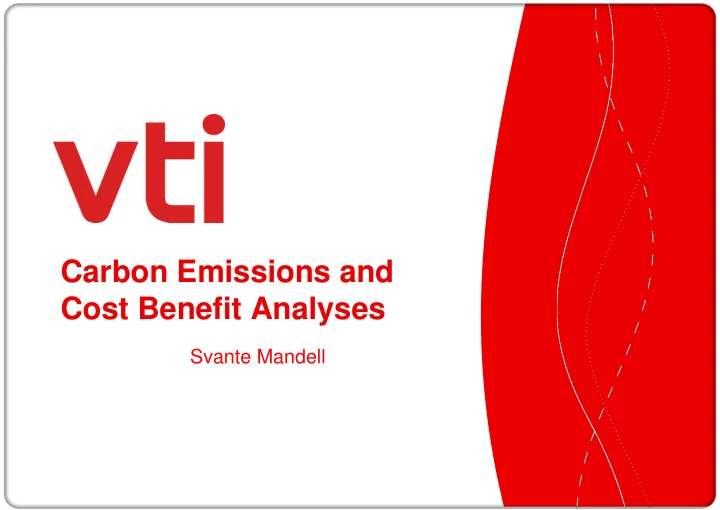

Carbon Emissions and Cost Benefit Analyses Svante Mandell
Question Project CBAs, e.g., for infrastructure investments, require a value for CO 2 reductions Where to look for that value? Here, address the principles – not the value itself Heavily colored by the debate in Sweden Based on; Mandell, S. (2011), “Carbon Emission Values in Cost Benefit Analyses”, Transport Policy,18(6), 888-892
Alternatives Policy makers Social Cost of Carbon Policy induced cost (SCC) CBA
Social cost of carbon ”Direct” approach Calculate (monetary) the damage from one extra unit of emission Typically by ”Integrated Assessment Models” The damage depends on concentration (not flow) CO 2 remains in atmosphere and is fully mixed Discounting, fairness, climate response, baseline etc will have large impact on outcome
SCC estimates, SEK / kg CO 2 Mutliply by 100 for € /ton Data from Tol (2008) Estimated SCC [SEK / kg CO2] 211 SCC-estimates 180 160 47 studies Number of estimates 140 120 100 Three estimates: 80 3.2 from 1992 60 2.9 & 4.6 two (out of 20) 40 estimates from the same 20 study (2005) 0 -0.4 -0.2 0 0.2 0.4 0.6 0.8 1 1.2 1.4 1.6 1.8 2 2.2 Larger Stern; 0.6 Long term value used in Sweden Short term value used in Sweden (equal to CO2-tax on fuel)
Policy induced price (or marg. cost) Existing (and future) policy creates a price for carbon o This should under mild conditions equal the marginal cost of reaching the target o I.e. equivalent with calculating the marginal abatement cost for reaching the target Sometimes easy to estimate o Emissions tax o Tradable permit scheme In other situations; complicated
Which approach to use SCC is crucial for climate policy. Using policy induced costs for climate policy yields a circularity Pearce (2005); ” whatever the governments agree to do is in some o sense the ’right’ thing ” However, for CBA:s of non-climate policy projects, e.g., infrastructure investment; the value must be in line with the overarching climate policy
Policy maker Social Cost of Carbon Climate policy (SCC) induced cost Project CBA
Why? Emission trading schemes Consider a project covered by emissions trading o A project that reduces emissions locally or in a given sector o …does not reduce total emissions Only a reallocation of abatement burdens o Benefit; that someone else may emit more (and saves on abatement costs) o Value; the marginal abatement cost o Which, given a functional market, equals the permit price Using SCC in this case will yield incorrect results
Why? Taxed sector In the EU – same argument as for the ETS o There is still an emission bubble But true even disregarding the bubble argument o Consider a weak policy (compared to SCC) – Policy induced price < SCC o If infrastructure investment CBAs use SCC o invest in infrastructure not demanded given the actual policy Consequently, not cost effective
Thus… Both approaches are necessary But at different ”levels” The policy induced cost-approach is often used But motivated as a second-best approach Which I believe is wrong…
Additional questions • Should the value of carbon be same or different across countries, across sectors, and across modes; • Should values be consistent or flexible over time, considering the uncertainties over abatement costs in the future; • How well the trading scheme and market work in relation to attaching a value to CO 2 emissions; • Are there factors that give rise to particular concern in relation to methodologies for the assessment of policies for sustainable transport in Sweden?
My response (1) Should the value of carbon be same or different across countries, across sectors, and across modes? (Unfortunately) yes! As they should mirror the expected policy that may differ Which, typically, will result in loss of cost effectiveness
My response (2) Should values be consistent or flexible over time, considering the uncertainties over abatement costs in the future? If policy is believed to increase carbon price over time, this should be mirrored in the carbon values Update values in response to new information? Yes – but may be costly, as it introduces uncertainties In my view, this is a problem on the climate policy level
My response (3) How well do the trading scheme and market work in relation to attaching a value to CO 2 emissions? In principle, very well. However, currently large surplus and an ongoing discussion on how to counter this Is there a (large) discount due to concerns about the future of the ETS?
My response (4) Are there factors that give rise to particular concern in relation to methodologies for the assessment of policies for sustainable transport in Sweden? Great pubilc climate concern, so it is often ’hijacked’ Example; current CO 2 tax ~100 € /tonne This figure is also used in short-term CBA Probably to a large extent fiscal
Thank you! Svante Mandell svante.mandell@vti.se
Recommend
More recommend